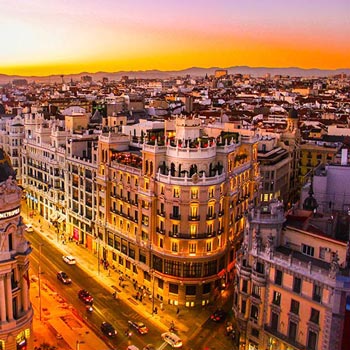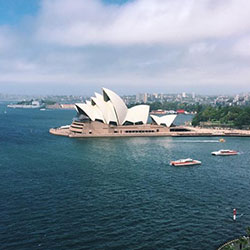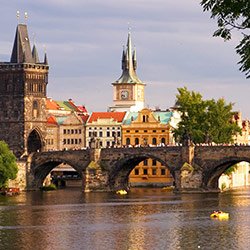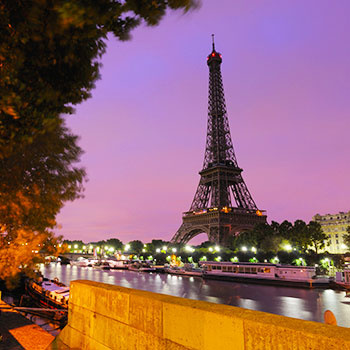All realms behold our driven seed,
Like wounded doves we fly their hate,
All nations hunt us and impede
And in the desert lie in wait...
Where is that kindness from above?
Solomon Ibn Gabirol (born 1020)
Silences
Evidence of the resurgence of anti-Semitism across America is both anecdotal and statistical.[1] At the same time, relative silence in education abroad environments suggests that concerns with justice, equity, diversity, and inclusion (the JEDI agenda) are not as inclusive as rhetoric might suggest.[2] Injustices enacted on marginalized peoples elsewhere have hardly caused a ripple of indignation. Physical and verbal assaults on American Jews have similarly been largely ignored.
The words of Rabbi Joachim Prinz at the March on Washington, August 28, 1963, are relevant:
In Berlin under the Hitler regime, I learned many things. The most important thing that I learned under those tragic circumstances was that bigotry and hatred are not the most urgent problem. The most urgent, the most disgraceful, the most shameful and the most tragic problem is silence (Starkman, 2013).
Contexts
American Jews are uniquely classified negatively from both right-wing and ostensibly progressive perspectives. The question "Are Jews White?" exemplifies the ideological context. The factual answer is, of course, not all Jews are White. That, however, is not of particular interest to those who ask the question. Jews are both not White and White depending on pre-determined assumptions. The shared delusion is that Jews are a race.
White supremacist Harold Covington argues that: "The race commonly known as Jews are...an Asiatic people, and shall not be considered White or accorded White racial status under law" (cited Baddiel, p. 47). In contrast, progressive rhetoric does not distinguish Jews from those enjoying White privilege. American Jews are, thus, excluded from the purity of Christian America and are, simultaneously, beneficiaries of unearned advantages.
However, hatred is built into English language in a way that separates Jews from mainstream White society. While Christian and Jewish are, in most cases, neutral descriptors, "Jew" when used as an adjective is inherently pejorative, an expression of hatred and disgust: Jew boy, Jew lawyer, Jew banker.[3] Additionally, the verb "to be jewed" was quite common in my youth; it means to be cheated.
Anti-Zionism is, frequently, employed as a quasi-justification for progressive-left attacks on Western Jews. They are uniquely held responsible for the actions of a country in which they do not live and whose policies they may well not support. This is a burden that no other group is required to carry. African Americans are not held responsible for, nor are they required to comment upon, the behavior of authoritarian governments in Chad or the Democratic Republic of the Congo. Americans of Korean descent are not held responsible for the government of North Korea; Buddhists for that of Myanmar. No Muslim in London or New York is held responsible for the barbarisms and repressions inflicted upon their citizens by the unelected governments of Afghanistan and Saudi Arabia.
The Black Lives Matter Movement focused on injustice within the US but made a single, international exception: "We are inspired by the people of Palestine who are rising up against Israel's continued apartheid." [4] Describing Israel as an apartheid state goes further than reasoned political critique. Comparing Hamas with the towering figures who fought oppression in South Africa distorts history. Aspirations for a Palestinian homeland do not justify teaching Holocaust denial in Hamas schoolbooks, or demonizing Jews through anti-Semitic caricature. There are no other countries in the world whose immediate neighbors have as their declared aim the obliteration of the other. I do not want to defend Israeli policies but rather to conduct the discourse in political terms, not as matters of ancient hatreds and persistent stereotypes.
The comparison with apartheid is made very consciously to legitimize international anti-Semitism. The reality is that Arab citizens of Israel comprise just over 20% of the population and have the same legal rights as Jewish Israelis. Labor laws protect citizens, Jewish and Arab; the rights of women are demonstrably more secure than in the US; an Arab political party - Ra'am - entered coalition government for the first time in 2021. Discrimination certainly exists; tensions that reflect the broader regional conflicts erupt at times into violence. Sadly, such community discord is not unique to Israel as evidenced by, for example, events in a number of American cities in recent times.
I am a largely secular Jew living in the UK. My political convictions are rooted in left-wing liberalism. I am not a Zionist. I recognize that there are valid criticisms of Israel, and of other countries in the region. However, to describe Israel as an apartheid state is to misrepresent with historical blindness and malicious intent.
I lift my lamp beside the golden door: Historical Contexts
Traditional hatred of Jews, rooted in Christian mythology, persists, but there are some specific American histories and mythologies that are significant. Stories of national origin present America as a haven for persecuted religious outcasts from Europe. That new structures of intolerance emerged does not alter the power of the mythology.
Peter Stuyvesant (c. 1610-August 1672) demonstrates this paradox. He is an iconic figure in the early history of New York City, commemorated in landmarks and statues.
He was also a rabid anti-Semite. In 1654, Stuyvesant wrote to Dutch West India Company officials that "the deceitful race, - such hateful enemies and blasphemers of the name of Christ, - be not allowed to further infect and trouble this new colony." Stuyvesant draws upon two persistent tropes: Jews are responsible for Christ's suffering and are carriers of infection. [5]
Nevertheless, America was a haven for persecuted and impoverished European peoples. For Jews, suffering intensified persecution in 19th-century Eastern Europe, America was a myth as well as a geographical location. Mary Antin, who came from Europe in 1891, describes perceptions of America in the shtetl[6] in the 1880s:
America was in everybody's mouth...children played at emigrating...all talked of it, but scarcely anyone knew one true fact about this magic land (1899, p. 12).
The notion of "magic" transforms reality into myth. It was the golden land where, in the yearning mind, beleaguered European Jews could dream of a new Jerusalem. The words engraved on the pedestal of the Statue of Liberty in New York harbor were written by a Jewish poet, Emma Lazarus:
Give me your tired, your poor,
Your huddled masses yearning to breathe free,
The wretched refuse of your teeming shore;
Send these, the homeless, tempest-tost to me,
I lift my lamp beside the golden door.
("The New Colossus" 1883).
Many immigrant Jews enjoyed success in employment areas from which they were not excluded. Well into the 20th century some professional fields were impenetrable and major universities operated quotas that limited Jewish enrollment. This made City College of New York a particular attraction for Jewish students as it had, from its beginnings, opened its doors without discrimination.
Exclusion from traditionally White protestant institutions and careers led to Jews seeking opportunities as entrepreneurs and entertainers (Al Jolson, the Marx Brothers, Zero Mostel, etc.) in Hollywood - a new field without traditional rules and restraints. With other immigrants, they also were influential in crime (e.g., Bugsy Siegel, Meyer Lansky). By the 1960s and 70s, Jews had penetrated traditional professions while also continuing to work in smaller entrepreneurial areas. They made powerful and lasting impacts in Hollywood and had become highly influential in American literature (the "trinity" - Saul Bellow, Bernard Malamud, and Philip Roth, in particular).
However, American Jews were also subject to persistent stereotypes which became manifest at various levels of intensity in relation to evolving circumstances. They were seen as simultaneously unhygienic, privileged, a secret cabal of powerful capitalists, subversive alien communists, stateless cosmopolitans with no loyalty to America. Those were the narratives that inspired hundreds of years of bigotry.
Anti-Semites
Peter Stuyvesant was one of the first of many in American history who perpetrated hostility against Jews. Many others followed in that tradition. A very selective set of examples: in 1899, Henry Adams lamented that "we are in the hands of the Jews [who] can do what they please with our values" (Dobkowski, 1979, pp. 124-5). Christopher Bigsby describes the content of White House tapes some 70 years later:
In 2002, some of the tape recordings made by Richard Nixon in the early 1970s... came into public domain. They revealed Billy Graham...remarking that "the Bible says there are satanic Jews and that's where our problem arises," while Nixon claimed that "the Jews are an irreligious, atheistic, immoral bunch of bastards" (p. 255).
In the 1930s and early 1940s, international crises intensified anti-Semitism. Charles Lindbergh (1902-1974) was renowned as the first aviator to complete a solo transatlantic flight in 1927. He was also the recipient of national sympathy when, in 1932, his 20-month-old son was kidnapped and murdered. His role as spokesman for the America First Committee (1940-41) is less well known. On September 11, 1941, he identified Jews as one of the groups responsible for forcing the US into World War II:
Instead of agitating for war, Jews in this country should be opposing it in every way, for they will be the first to feel its consequences. Their greatest danger to this country lies in their large ownership and influence in our motion pictures, our press, our radio and our government.
He enjoyed the support of one of the most prominent anti-Semites of those times. Charles E. Coughlin (1891-1979) was ordained as a Catholic priest in 1919. Throughout the 1930s, his weekly radio broadcasts attracted an audience estimated between 9 and 30 million.
His response to Nazi violence was to blame the Jews: "Jewish persecution only followed after Christians first were persecuted." He added, "when we get through with the Jews in America, they'll think the treatment they received in Germany was nothing."
Coughlin represented an ethos in which extreme anti-Semitism found populist support as World War II approached. He expressed some persistent tropes. Jews are greedy capitalists and, simultaneously, Communists whose loyalties clash with the national interest. Furthermore, they are responsible for their own persecution.
The idea of the Jews as a rootless elite was exemplified in The Protocols of the Elders of Zion.[7] First published in 1903 in Russia, the document purports to outline a Jewish conspiracy to take over the world. It has had a remarkable longevity and it is still sold in many parts of the world, especially in the Middle East. In America, Henry Ford financed publication in the 1920s with Coughlin's support. Ford's unremitting hatred was also given voice in The Dearborn Independent, the newspaper he owned from 1919 through 1927. The front page carried a weekly message describing "The International Jew: The World's Problem"; the collocation of International and Jew was used to categorize the source of national ills. A four-volume set of essays, also titled The International Jew, published by Ford's Dearborn Publishing Company, was publicly admired by Hitler. In 1938 the Nazi regime awarded Ford the Grand Cross of the German Eagle, the highest award that could be given to a non-German.
Monuments to proponents of racism have been removed across the US. Statues commemorating Stuyvesant, Lindbergh, and Henry Ford remain largely untroubled.
Literary Stereotypes
English and American literature throws up a myriad of writers who present Jews through negative stereotypes. The smallest sample would include Ezra Pound, T. S. Eliot, Ernest Hemingway, Scott Fitzgerald, Evelyn Waugh, Graham Greene, and lesser lights such as, notoriously, G.K. Chesterton, Agatha Christie, John Buchan, and so on, ad nauseam.
Perhaps the most disturbing examples of anti-Semitism are found in the works of contemporary writers we otherwise admire. Alice Walker's poem "It Is Our (Frightful) Duty To Study The Talmud" contains extreme anti-Zionist rhetoric: "demonic/To the core." Her version of the Talmud draws upon traditional calumnies rooted in medieval bigotry. The transition from anti-Zionism to anti-Semitism is explicit:
I recommend starting with YouTube. Simply follow the trail of "The
Talmud" as its poison belatedly winds its way...
Are Goyim (us) meant to be slaves of Jews, and not only
That, but to enjoy it?
Are three year old (and a day) girls eligible for marriage and intercourse?
Are young boys fair game for rape? (Walker, 2017).
Walker's "research" on YouTube (!) voices ancient bigotry. Clearly, she did not unearth the injunction of Hillel the Elder (c. 110 BCE to 10 CE) recorded in The Babylonian Talmud:
That which is hateful to you, you do not do to your fellows. That is the whole Torah; the rest is explanation.
Nor did she recognize the reiteration by Jesus in the Sermon on the Mount:
Therefore all things whatsoever ye would that men should do to you, do ye even so to them: for this is the law and the prophets (KJV Matthew 7:12).
Walker repeatedly endorses the work of David Icke - Holocaust denier and anti-Semite. The African American writer Nylah Burton expresses outrage at Walker's promotion of Icke's And the Truth Shall Set You Free:
which contains some of the most hateful anti-Semitic lies ever to be printed between covers...Icke's book alleged that a "small Jewish clique" had created the Russian Revolution and both World Wars, and "coldly calculated" the Holocaust to boot. (2018).
The playwright and poet Amiri Baraka (formerly known as LeRoi Jones and Imamu Amear Baraka: 1934-2014), whatever else he may have written, also wrote: "We want... dagger poems in the slimy bells of the owner-jews... Look at the Liberal Spokesman for the jews clutch his throat and puke himself into eternity..." After 9/11, he perpetuated the anti-Semitic conspiracy theory that Jews were behind the attacks.
The standard defense of literary anti-Semitism is that it reflects the attitudes of the times and that is sadly the case. Hatred of Jews is embedded within the fabric of Western thought. I'm not suggesting that we no longer teach authors who exhibit such views. There wouldn't be much left to teach if we did. However, blindness to persistent prejudice is not a valid moral or intellectual option. The strategy through which we seek to decolonize literary studies applies here; teach the whole context, not some sanitized version of reality.
Conclusion
A report by the Anti-Defamation League (2021) itemizes many examples of the ways in which Jews are imagined as secret conspirators responsible for numerous atrocities:
Antisemites attribute mass shootings in the U.S., including Sandy Hook and El Paso, ...to the machinations of Jews or Zionists. Some conspiracy theorists draw direct lines between alleged Jewish responsibility for the 9/11 attacks and the 2008 financial crisis...Jews and Zionists have also been blamed for the January 6 insurrection at the Capitol (ADL, 2021).
This is traditional scapegoating; Jews are responsible for pollution and destruction in Christian communities; motives are secret and demonic.
More visible communities, Hassidic Jews in particular, are, increasingly, subject to demonization, violence, and the rhetoric of prejudice. None of this is unique or exceptional, but it does signify that America is far from immune from historical hatreds. Rather like the hidden history of labor radicalism, American anti-Semitism collides with an embedded national myth: "I lift my lamp beside the golden door." That is no excuse or explanation for the exclusion of Jews from the discourses of JEDI.
Of course, many American Jews have entered into the center of American social, artistic, economic, and political life. They are, largely, assimilated within the national ethos. As indeed were the Jews of Germany and France in the years before darkness fell.
---
Endnotes
[1] See for example:
https://www.nytimes.com/2022/11/04/us/kanye-antisemitism-midterms.html
https://www.pewresearch.org/religion/2021/05/11/anti-semitism-and-jewish-views-on-discrimination/
[2] I recently argued this in: https://capaworld.capa.org/justice-equity-diversity-inclusion-international-perspectives
[3] See Baddiel for an extended discussion of these factors.
[4] https://m4bl.org/statements/end-us-complicity-in-israels-abuses-of-palestinians/
[5] The concept of Jews as carriers of infection is found throughout history and in most national contexts. In the bestseller La France juive, for example, Edouard-Adolphe Drumont describes Jews as "a sort of perpetual discharge which is impossible to stop...dropping vermin wherever they pass, offering a constant danger for public health" (1886, v.1., p. 456).
[6] The Yiddish word literally means town, but it has come to signify small Jewish towns and villages in pre-World War II Eastern Europe. It has become associated with a lost way of life, marked by religious observance and social cohesion. The film Fiddler on the Roof (1964) may sanitize shtetl life, but it also represents the violence, insecurities, and poverty behind the idea of America as an alternative, "magical land."
[7] The Protocols is a notable forgery that describes a Jewish conspiracy to dominate the world and blames Jews for the disorders that befall Christian civilization. See, for example, https://encyclopedia.ushmm.org/content/en/article/protocols-of-the-elders-of-zion https://www.adl.org/resources/backgrounders/a-hoax-of-hate-the-protocols-of-the-learned-elders-of-zion
---
Selected Sources
ADL REPORT. "Antisemitic Conspiracies About 9/11 Endure 20 Years Later" 2021. https://www.adl.org/resources/reports/antisemitic-conspiracies-about-911-endure-20-years-later
Mary Antin, From Plotzk to Boston. Boston: W.B. Clarke, 1899.
David Baddiel. Jews Don't Count. London: TLS Books, 2021.
Christopher Bigsby, Arthur Miller 1951 - 1962. London: Weidenfeld and Nicolson, 2008.
Nylah Burton, "Alice Walker's Terrible Anti-Semitic Poem Felt Personal - to Her and to Me." New York Intelligencer BAD POETRY DEC. 28, 2018. https://nymag.com/intelligencer/2018/12/alice-walkers-anti-semitic-poem-was-personal.html
Harold A. Covington. Dreaming the Iron Dream: Collected Racial and Political Essays of Harold A. Covington. York, S.C.: Liberty Bell, 2005.
Michael N Dobkowski. The Tarnished Dream: The Basis of American Anti-Semitism. Westport: Greenwood Press, 1979.
Edouard-Adolphe Drumont. La France juive, essai d'histoire contemporaine. Paris: Marpon et Flammarion, 1886.
Susan Starkman. Joachim Prinz: I Shall Not Be Silent. Teacher Resource Package, 2013. http://tjff.com/media/Joachim_Study_Guide.pdf.
Alice Walker. https://alicewalkersgarden.com/2017/11/it-is-our-frightful-duty-to-study-the-talmud/










